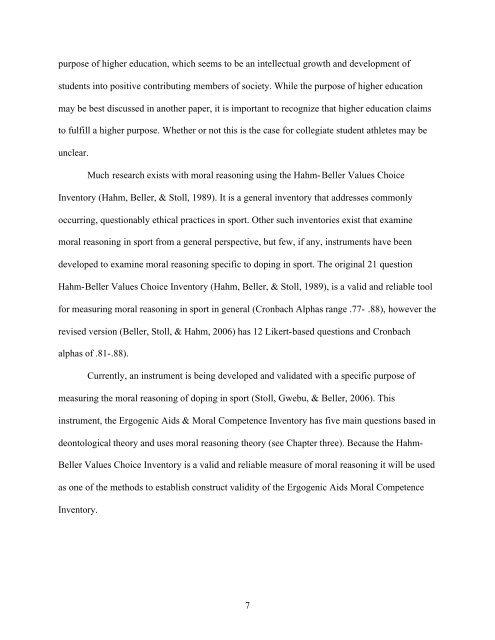the moral reasoning of student athletes and athletic training students
the moral reasoning of student athletes and athletic training students
the moral reasoning of student athletes and athletic training students
You also want an ePaper? Increase the reach of your titles
YUMPU automatically turns print PDFs into web optimized ePapers that Google loves.
purpose <strong>of</strong> higher education, which seems to be an intellectual growth <strong>and</strong> development <strong>of</strong><br />
<strong>student</strong>s into positive contributing members <strong>of</strong> society. While <strong>the</strong> purpose <strong>of</strong> higher education<br />
may be best discussed in ano<strong>the</strong>r paper, it is important to recognize that higher education claims<br />
to fulfill a higher purpose. Whe<strong>the</strong>r or not this is <strong>the</strong> case for collegiate <strong>student</strong> <strong>athletes</strong> may be<br />
unclear.<br />
Much research exists with <strong>moral</strong> <strong>reasoning</strong> using <strong>the</strong> Hahm-Beller Values Choice<br />
Inventory (Hahm, Beller, & Stoll, 1989). It is a general inventory that addresses commonly<br />
occurring, questionably ethical practices in sport. O<strong>the</strong>r such inventories exist that examine<br />
<strong>moral</strong> <strong>reasoning</strong> in sport from a general perspective, but few, if any, instruments have been<br />
developed to examine <strong>moral</strong> <strong>reasoning</strong> specific to doping in sport. The original 21 question<br />
Hahm-Beller Values Choice Inventory (Hahm, Beller, & Stoll, 1989), is a valid <strong>and</strong> reliable tool<br />
for measuring <strong>moral</strong> <strong>reasoning</strong> in sport in general (Cronbach Alphas range .77- .88), however <strong>the</strong><br />
revised version (Beller, Stoll, & Hahm, 2006) has 12 Likert-based questions <strong>and</strong> Cronbach<br />
alphas <strong>of</strong> .81-.88).<br />
Currently, an instrument is being developed <strong>and</strong> validated with a specific purpose <strong>of</strong><br />
measuring <strong>the</strong> <strong>moral</strong> <strong>reasoning</strong> <strong>of</strong> doping in sport (Stoll, Gwebu, & Beller, 2006). This<br />
instrument, <strong>the</strong> Ergogenic Aids & Moral Competence Inventory has five main questions based in<br />
deontological <strong>the</strong>ory <strong>and</strong> uses <strong>moral</strong> <strong>reasoning</strong> <strong>the</strong>ory (see Chapter three). Because <strong>the</strong> Hahm-<br />
Beller Values Choice Inventory is a valid <strong>and</strong> reliable measure <strong>of</strong> <strong>moral</strong> <strong>reasoning</strong> it will be used<br />
as one <strong>of</strong> <strong>the</strong> methods to establish construct validity <strong>of</strong> <strong>the</strong> Ergogenic Aids Moral Competence<br />
Inventory.<br />
7

















